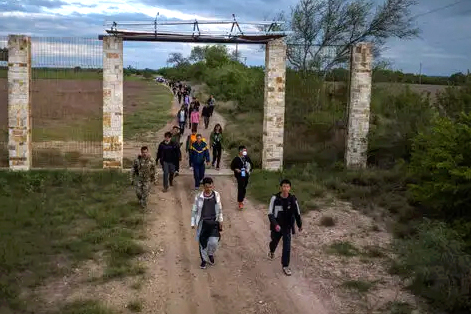|
|
|
|
|
|
 |
|
|
A family
sit in a
vehicle
with a
cage
door.
The
family
of
migrants
from
China in
Texas
after
surrendering
to
Border
Patrol
in
April.
Credit...Reuters |
| |
Growing
Numbers
of
Chinese
Migrants
Cross
U.S.
Southern
Border
By
Eileen
Sullivan
nytimes.com
More
than
24,000
Chinese
citizens
have
been
apprehended
crossing
into the
United
States
from
Mexico
in the
past
year.
That is
more
than in
the
preceding
10 years
combined.
The
surge of
migrants
entering
the
United
States
across
the
southern
border
increasingly
includes
people
from a
surprising
place:
China.
Despite
the
distances
involved
and the
difficulties
of the
journey,
more
than
24,000
Chinese
citizens
have
been
apprehended
crossing
into the
United
States
from
Mexico
in the
past
year.
That is
more
than in
the
preceding
10 years
combined,
according
to
government
data.
They
typically
fly into
Ecuador,
where
they do
not need
a visa.
Then,
like
hundreds
of
thousands
of other
migrants
from
Central
and
South
America
and more
distant
locations,
they pay
smugglers
to guide
their
travel
through
the
dangerous
jungle
between
Colombia
and
Panama
en route
to the
United
States.
Once
there,
they
turn
themselves
in to
border
officials
and many
seek
asylum.
And most
succeed,
in turn
fueling
further
attempts.
Chinese
citizens
are more
successful
than
people
from
other
countries
with
their
asylum
claims
in
immigration
court.
And
those
who are
not end
up
staying
anyway
because
China
usually
will not
take
them
back.
In the
polarizing
debate
over
immigration,
it is a
little-discussed
wrinkle
in the
U.S.
system:
American
officials
cannot
force
countries
to take
back
their
own
citizens.
For the
most
part,
this is
not an
issue.
But
about a
dozen
countries
are not
terribly
cooperative,
and
China is
the
worst
offender.
Of the
1.3
million
people
in the
United
States
with
final
orders
to be
deported,
about
100,000
are
Chinese,
according
to an
administration
official
who
spoke on
the
condition
of
anonymity
to
discuss
the
internal
data.
The
migrants
are part
of an
exodus
of
citizens
who have
grown
frustrated
with
harsh
restrictions
related
to the
coronavirus
pandemic
and the
direction
of Xi
Jinping’s
authoritarian
government.
The
trend
has been
coined
the “run
philosophy,”
with
citizens
escaping
to
Japan,
Europe
and the
United
States.
“The
largest
reason
for me
is the
political
environment,”
Mark Xu,
35, a
Chinese
elementary
and
middle
school
English
teacher,
said in
February,
as he
waited
to board
a boat
in
Necoclí,
Colombia,
a beach
town in
the
north.
China
was so
stifling,
he
added,
it had
become
“difficult
to
breathe.”
He was
among
about
100
Chinese
migrants
setting
off that
morning
to start
the
journey
through
the
treacherous
Darién
Gap, the
only
land
route to
the
United
States
from
South
America.
Mr. Xu
said he
learned
about
the trek
from
YouTube
and
through
Google
searches,
including
“how to
get
outside
of
China”
and “how
to
escape.”
In the
last two
years,
the area
has been
one of
the most
difficult
portions
of a
desperate
journey
for
large
numbers
of
migrants
seeking
to go
north.
So far,
481,000
people
have
crossed
through
the
jungle
this
year,
compared
with
248,000
last
year,
according
to
Panamanian
officials.
Most of
the
migrants
have
been
Venezuelans,
Ecuadoreans
and
Haitians
fleeing
crises
at home,
including
economic
and
security
problems.
But this
year,
more and
more
Chinese
have
embarked
on the
journey.
So many
have
crossed
that
Chinese
citizens
are now
the
fourth-largest
group
traversing
the
jungle.
Many fly
to
Turkey
before
heading
to
Ecuador
and
making
their
way to
the
United
States.
More
than
24,000
came to
the
United
States
during
the 2023
fiscal
year,
according
to
government
data.
Over the
previous
10
years,
fewer
than
15,000
Chinese
migrants
were
caught
crossing
the
southern
border
illegally.
The
historic
levels
of
migration
across
the
southern
border
are a
major
political
problem
in the
United
States,
where
President
Biden
faces
fierce
pressure
to curb
the
flow;
the
Chinese
migrants
are a
small
fraction.
Most who
have
come to
the
United
States
in the
past
year
were
middle-class
adults
who have
headed
to New
York
after
being
released
from
custody.
New York
has been
a prime
destination
for
migrants
from
other
nations
as well,
particularly
Venezuelans,
who rely
on the
city’s
resources,
including
its
shelters.
But few
of the
Chinese
migrants
are
staying
in the
shelters.
Instead,
they are
going
where
Chinese
citizens
have
gone for
generations:
Flushing,
Queens.
Or to
some,
the
Chinese
Manhattan.
“New
York is
a
self-sufficient
Chinese
immigrants
community,”
said the
Rev.
Mike
Chan,
the
executive
director
of the
Chinese
Christian
Herald
Crusade,
a
faith-based
group in
the
neighborhood.
Newcomers
do not
have to
speak
English
because
so many
speak
Mandarin
or
Cantonese,
he
added,
making
it
easier
to find
a job as
well.
That
kind of
network
helps
people
find
immigration
lawyers,
housing
and
other
basic
needs.
Their
route to
Flushing
through
a South
American
jungle
is what
makes
the most
recent
arrivals
different.
In the
past,
most
Chinese
asylum
seekers
have
come on
a visa
and then
applied
once
they
were in
the
United
States.
The last
time
such an
influx
of
Chinese
migrants
entered
illegally,
they
came by
sea in
the
1990s.
But the
current
volume
is much
higher.
“America
is the
greatest
power in
the
world,
isn’t
it?” a
29-year-old
Chinese
migrant
who
would
identify
himself
only by
his
nickname
and
surname,
Little
Xu, said
recently
outside
a
Taiwanese
tea shop
in
Flushing.
Mr. Xu
was
taking a
break
from his
job as a
messenger
and
asked
that his
full
name not
be used
out of
fear of
retribution.
He left
China,
he said,
to find
work.
“I’ve
lost
hope
where I
lived,”
he said,
describing
his job
as a
jewelry
salesman
in
central
Hubei
Province
and how
his boss
had
stopped
paying
him. Mr.
Xu
arrived
in
Flushing
in
August
after a
two-month
journey
from
China,
which
included
hiking
through
the
jungle
in rain
so heavy
that his
shoes
ripped
open.

A group
walks
down a
dirt
road. Of
the 1.3
million
people
in the
United
States
with
final
orders
to be
deported,
about
100,000
are
Chinese.Credit...Reuters
Migrants
seeking
asylum
have to
wait
about
six
months
after
they
file
their
application
to get
permission
to work
legally.
More
recent
arrivals
will
wait
years
for
their
cases to
wind
through
the
system.
In
general,
Chinese
asylum
seekers
are more
successful
in
immigration
court
than
most.
About 67
percent
of
applicants
from
China
were
granted
asylum
from
2001 to
2021,
according
to data
analyzed
by the
Transactional
Records
Access
Clearinghouse
at
Syracuse
University.
And
those
who are
ordered
removed
are not
likely
to be
deported.
Muzaffar
Chishti,
a senior
fellow
with the
nonpartisan
Migration
Policy
Institute,
said as
long as
that
happened,
the
migration
trend
would
continue.
“If you
make it
to the
U.S.,
then
you’re
more
likely
than not
to be
able to
stay,”
he said.
“So it’s
absolutely
worth
the
chance
of
taking
that
risk.”
Still,
the
exodus
of
Chinese
citizens,
particularly
those of
working
age, to
the
United
States
and
elsewhere
presents
a
challenge
to China
in the
long
run,
according
to Carl
Minzner,
a senior
fellow
for
China
studies
at the
Council
on
Foreign
Relations.
For the
first
time in
60
years,
China’s
population
is
shrinking,
with
fewer
births
than
deaths.
And its
economy
is
growing
at its
slowest
rate in
40
years.
With
other
countries
that
have
refused
to take
back
their
citizens,
the
United
States
has
withheld
aid
money or
used
similar
leverage
to gain
cooperation.
It also
has the
ability
to
restrict
access
to
certain
visas,
as it
did in
2017
with
Cambodia,
Eritrea,
Guinea
and
Sierra
Leone.
But
those
have not
been
compelling
arguments
for
China,
which
receives
little
U.S.
aid. And
as its
relations
with the
United
States
have
deteriorated
over the
years,
the
issue
has not
appeared
to be a
priority.
When Mr.
Biden
and Mr.
Xi met
last
week
during
an
international
summit
in San
Francisco,
for
instance,
immigration
was
absent
in their
discussion.
Instead,
they
talked
about
fentanyl,
American
business
investment
in China
and
export
controls,
among
other
topics.
In the
past,
American
diplomats
have
tried to
work
with the
Chinese
government
to
persuade
it to
repatriate
its
citizens,
and the
response
has
tended
to be
the
same.
“They
would
just
plain
refuse
to
acknowledge
the
person
was
Chinese,”
said
Michele
Thoren
Bond, a
former
assistant
secretary
of state
who
worked
on these
issues.
“It is
not
credible
that a
country
that
documents
and
monitors
its
citizens
as
closely
as China
does not
have
photos
of every
citizen,”
Ms. Bond
added.
Reporting
was
contributed
by Mable
Chan and
Li Yuan
in New
York,
Julie
Turkewitz
in
Necoclí,
Colombia
and
Federico
Rios in
Medellín,
Colombia.
Advertise With Us:

Certified Minority Business Enterprise

|
|
|
|
|
|
|
|
|